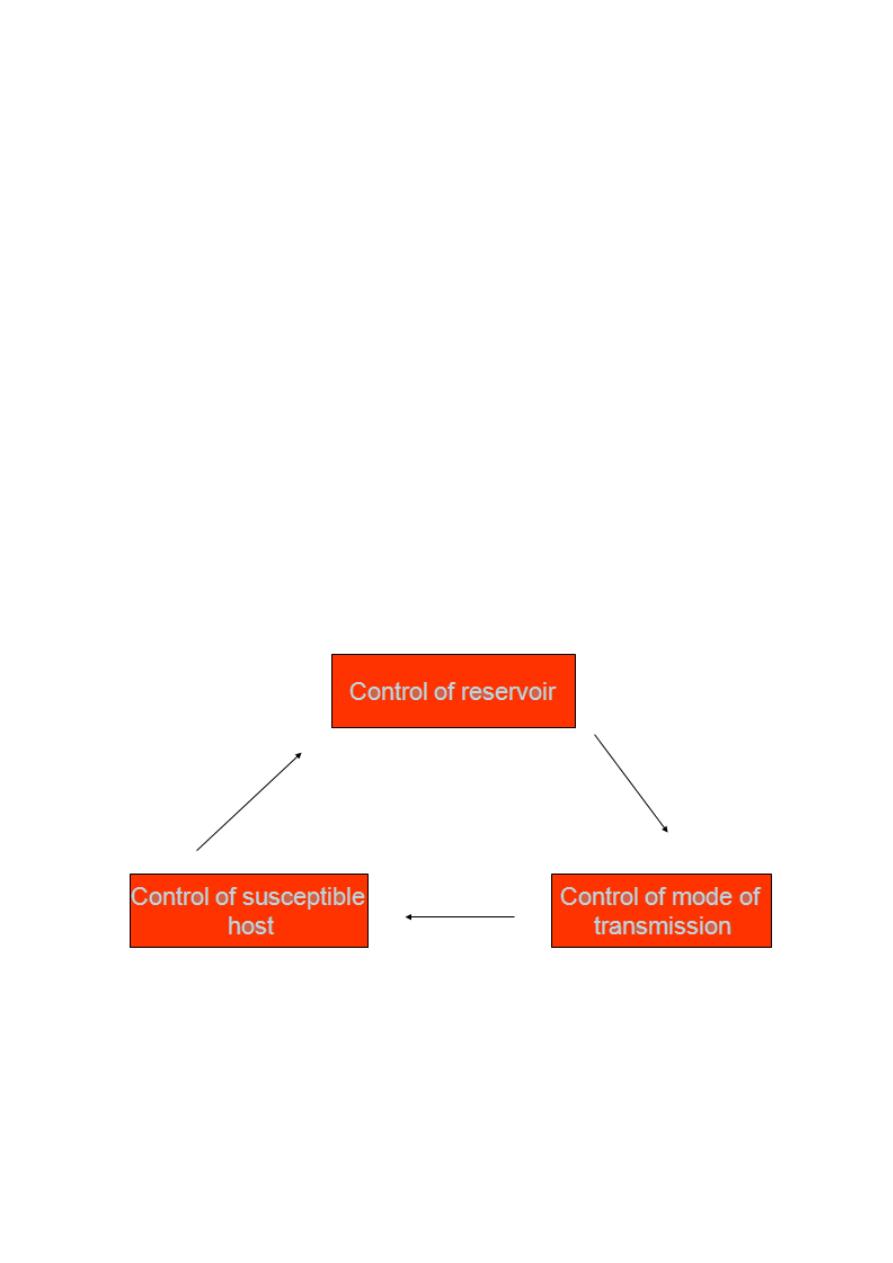
1
fourth stage
Community
Lec- 4
Dr.Nuha
11/11/2015
Prevention
&
Control of Infectious Diseases
Definitions
Infectious disease: A clinically manifested disease of human or animal resulting from
infection.
Infected individual :A person or animal ,that harbors an infectious agent & who has
either manifest disease or in apparent infection .
Infectivity : The ability of the infectious agent to enter, survive & multiply in the host.
Infectiousness: The relative ease with which an infectious agent is transmitted to other
hosts.
Infection: the entry & development or multiplication of an infectious agent in the body
of persons or animals.
In apparent infection : presence of infection in host without recognizable clinical signs
or symptoms.
Incubation period : the time interval between initial contact with an infectious agent &
the first appearance of symptoms associated with the infection .
Extrinsic incubation period: In vector ,it is the time between entrance of an organism
into the vector & the time when that vector can transmit the infection
Prepatent period : the period between the time of exposure to an infectious agent
&time when the agent can be detected in blood or stool.
Period of communicability :Is the time during which an infectious agent may be
transmitted directly or indirectly from an infected person to another, from infected
animal to humans, or from infected person to animals.

2
Chain of infection
Reservoir
Any person ,animal ,arthropod ,plant, soil ,or substance (or combination of these) in which
an infectious agent normally lives & multiplies ,on which it depends primarily for survival, &
where it reproduces itself in such manner that it can be transmitted to a susceptible host .
Reservoir is of three types
Human reservoir
Animal reservoir
Reservoir in non-living things
Carrier
A person or animal that harbors a specific infectious agent without clinical disease &
serves as a potential source of infection.
As a rule carriers are less infectious than cases but more dangerous ,because they
remain hidden and readily infect susceptible individual.
Elements of carrier state:
Disease agent is presents in the host
Absence of signs and symptoms
Shedding of disease agent in discharge and excretion and act as source of
infection to others

3
Carrier state classified as below
1. Type
• Incubatory carriers: those who shed the infectious agent duration incubation period
• Convalescent carriers: those who continue shedding infectious agent duration
convalescent period.
• Healthy carriers: victims of subclinical infection and develop carrier state.
2. Duration
• Temporary 6-12 months.
• Chronic more than 12 months
• Permanent for life
3. Portal of exit
Respiratory, urinary, intestinal, others
Mode of Transmission
I.
Direct
• Physical contact
• Droplet
• Trans placental
II.
Indirect
• Vehicle (Water, Milk ,Blood, Surgical instruments…….etc).
• Insect
• Air (droplet nuclei)
• Soil
III.
Both

4
Prevention and control of infectious diseases
Prevention and Control : Standard Measures
- Hand hygiene
- Use of personal protective equipment
- Promotion of safe injection practices
- Handling and disposal of sharp equipments and materials
Prevention and Control : Standard Precautions
- Waste management
- Cleansing, disinfection and sterilization of patient care equipments.
- Isolation measures
- Use of aseptic techniques
Principles of control

5
Control of reservoir
1. Recognition
- Clinical signs& symptoms
- Laboratory investigation
2. Notification.
3. Isolation (period of communicability)
4. Treatment
5. Disinfection
6. Quarantine
Control of mode of transmission
Major aspect of communicable disease control is to break the chain of transmission .
Examples :
• Chlorination of water to control diseases like typhoid, hepatitis A, cholera…….etc
• Control of breeding places of mosquito in case of malaria
• Environmental control (proper sewage disposal)
Control of susceptible host
- Active immunization
- Passive immunization
- Chemoprophylaxis
• Cholera
• Diphtheria
• Meningitis
• Malaria
Epidemic measures : Procedures of an emergency character designed to limit the spread of
communicable disease that has developed widely in a group or community, or within area,
state or nation.

6
International measures : interventions designed to protect population against the known
risk of infection from international source.
Isolation
Applied to the patient , represent separation for a period of communicability of infected
person, from others in such places & under such conditions as to prevent or limit the
spread to those who are susceptible to the disease .
Strict isolation
Highly infectious disease.
Spread by air & contact.
- Use of mask, gowns& gloves for all persons entering the room.
- Private room.
- Special ventilation device.
Contact isolation
Less highly transmissible disease.
Transmitted by close or direct contact.
- Private room for more than one patient infected with the same organism.
- Mask for those who come in close to patient .
- Gown & gloves if soiling is likely.
Respiratory isolation
To prevent transmission of infectious disease over short distance by air.
- Private room is indicated.
- Pt with the same organism may share.
- Masks for those who are in close contact.
- Gowns & gloves are not indicated.

7
T.B isolation
for patients with active pulmonary T.B.
- Private room with special ventilation & closed door.
- Those entering the room must use respiratory masks.
- The use of gowns will prevent gross contamination of clothing .
- Gloves are not indicated.
Enteric precautions
Applied for infections transmitted by direct or indirect contact with feces .
- Use of private room if patient hygiene is poor.
- Masks are not indicated .
- Gowns should be used if soiling is likely.
- Gloves used when touching contaminated materials .
Disinfection
Killing of infectious agents outside the body by direct exposure to chemical or physical
agents.
Types :
1. Concurrent disinfection: Application of disinfection measures as soon as possible after
discharge of infectious material from the body of an infected person or after soiling of
articles with such infectious discharges.
2. Terminal disinfection : Application of disinfection measures after the patient has been
removed by death or to the hospital or he has ceased to be a source of infection or after
hospital isolation.
Quarantine
Restriction of activities of well person or animals who have been exposed to case of
communicable disease during its period of communicability to prevent disease transmission
during incubation period.

8
Personal Surveillance
Close medical observation of contacts to permit prompt recognition of infection or illness
but without limitation of movement
Complete or Absolute Quarantine
The limitation of freedom of movement of those exposed to the communicable disease for
period of time not longer than the longest incubation period of that disease ,in such
manner as to prevent effective contact with those not exposed.
Modified QUARANTINE
Partial limitation of freedom of movement of contact e.g. exclusion of children from school
